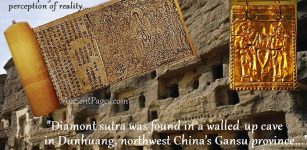Mysterious Viking Burial Site Of Three Women In Norway Reveals Its Secrets
Jan Bartek - AncientPages.com - Archaeologists have made a significant discovery on a small rocky knoll along Norway's west coast, uncovering a burial ground dating back to the Viking Age. Metal detector enthusiasts initiated this finding by discovering a coin and a brooch with textile fragments while exploring the Skumsnes farm in Fitjar last year.
Researchers from the University of Bergen have confirmed that these artifacts originate from a Viking Age burial site. They estimate that there could be approximately 20 graves at this location.
"Many of the buried individuals were adorned with fine jewelry. It is remarkable to find a burial ground with such well-preserved artifacts," says archaeologist Søren Diinhoff from the University Museum of Bergen.
"From a research perspective, this is a small treasure trove," he says.
This autumn, three graves were excavated, revealing the remains of three women who lived during the early Viking Age, specifically in the first half of the 9th century. During this period, a significant farm was located at Skumsnes. A local or regional king in western Norway likely owned this farm.
Once a beautiful piece of jewelry consisting of over 40 beads and 11 silver coins. The silver coins are Carolingian, dating from the first half of the 9th century. (Photo: University Museum of Bergen)
46 glass beads is a lot, according to archaeologist Unn Pedersen, an expert on jewelry from the Viking Age. As people became more financially secure during the Viking Age, they could also afford more jewelry. The most popular jewelry was mass-produced in big cities. (Photo: University Museum of Bergen)
"Below the level of royal estates, we find strategic farms like Skumsnes," says Diinhoff.
Its location along the coast probably made it attractive to travelers needing a safe harbor.
"On behalf of the king, shelter was provided to passing ships, which likely generated additional income," he believes.
This explains why the graves are richer than those more commonly found.
The Most Remarkable Find
During the Viking Age, it was not uncommon for individuals to be interred in natural rock crevices along the coast, as explained by Diinhoff. One burial involved a woman laid to rest with costume jewelry and distinctive oval brooches used by Viking women to fasten their apron dresses. Notably, some of these jewelry pieces originated from England or Ireland.
Another woman of higher status was buried differently; her grave featured stones arranged in a boat shape with boat rivets inside.
The boat grave seen from above. The stones are arranged in a boat formation. In the center lies a larger stone that symbolizes the mast. Perhaps it also symbolizes the woman herself. (Photo: University Museum of Bergen)
Accompanying her into the afterlife was a four-meter-long boat. This grave also contained oval brooches, various pieces of costume jewelry, and an elaborate necklace made up of 46 glass beads and 11 silver coins. Among these coins is an exceptionally rare variant from the Danish Viking towns of Hedeby or Ribe, crafted in southern Denmark during the first half of the 9th century.
“That coin might be the most remarkable find here,” says Diinhoff. “I plan to have it tattooed this winter.”
Hedeby coins are a rare find. (Photo: Adnan Icagic / University Museum of Bergen)
According to archaeologist Søren Diinhoff, this coin is the most remarkable discovery so far from the women's graves at Skumsnes. (Photo: Adnan Icagic / University Museum of Bergen)
The other coins seem to be Carolingian silver coins, which are dated to the first half of the 9th century and originate from the Frankish Empire. This indicates that the woman likely had connections to continental Europe.
“Both of these women had contacts outside Norway. It's probably no coincidence. Perhaps they came from abroad and married into the local community,” Diinhoff speculates.
The woman interred in the boat grave was not solely accompanied by exquisite jewelry. She was also provided with wool shears, a hetchel, a spindle whorl, and a weaving sword—tools essential for textile production. Archaeologists suggest that she oversaw this aspect of work on the farm.
According to Diinhoff, "Textile production was prestigious. Farms that produced fine clothing were regarded with high status." Additionally, the presence of a bronze key in her grave suggests she held the position of head of the household.
Why Wasn't She Buried Wearing The Jewelry?
None of the graves contain any human remains. According to Diinhoff, this is a common issue in western Norway, where the soil tends to decompose bone remains. In one grave, glass beads and coins from a necklace were discovered atop a dark organic mass, leading archaeologists to speculate whether they might have been inside a leather pouch.
This raises questions about why the woman wasn't wearing her jewelry when buried or if she was ever buried at all. Some archaeologists propose that the grave could be a cenotaph—a memorial without an actual burial.
Keys have also been discovered in men’s graves, notes archaeologist Unn Pedersen. This shows that such items were not exclusive to housewives. However, a key often signifies someone in a position of management, someone with possessions worth locking away, which reflects status and wealth. (Photo: University Museum of Bergen)
This is the stone in the boat that archaeologists call a vulva stone. (Photo: University Museum of Bergen)
Adding intrigue to this theory is an interesting detail: in the center of the boat grave was a stone marking what would have been the mast of the boat. Upon examination, archaeologists noted its resemblance to what is known as a 'vulva stone' due to its likeness to female genitalia.
“That the stone resembles a woman is no coincidence. It's so obvious,” says Diinhoff.
As reported by Science in Norway, the placement of objects in the grave might symbolize a woman who was not actually buried there. This theory could explain why these items were discovered without an accompanying skeleton. The third grave remains partially excavated, as archaeologists uncovered so many artifacts in the first two graves that they ran out of time to continue.
A triangular brooch with glass mosaic and gold enamel from Ireland or England was found in the grave within the rock crevice. This grave had been opened earlier. Remains of the grave goods were found outside and around the grave. (Photo: University Museum of Bergen)
Despite this, they secured several items, including 20 beads and remnants of silver-plated jewelry. Additionally, two more graves have been identified, and experts estimate up to 20 graves could be within the area. Metal detectors have detected signals at various locations, suggesting further potential discoveries.
“The burial site lies just beneath the peat. The signals are so strong that we can almost pinpoint where the brooches are,” says Diinhoff.
Why Is The Hedeby Coin So Fascinating?
Archaeologist Unn Pedersen from the University of Oslo has confirmed that the Hedeby coin is a significant discovery. As an expert on the Viking Age, she has extensively studied jewelry, craftsmanship, and decorative objects from this period, providing valuable insights into its historical context.
“A silver coin like this on a bead necklace shows that the Viking Age was a time of transition,” she says.
A new form of trade was emerging, but gift exchange still dominated in Scandinavia. As a result, silver from this period is found in many different forms.
“For the woman buried here, it may have had greater value as jewelry. It may have told a story about her identity and the network she was part of,” says Pedersen.
“There’s an ongoing negotiation over the meaning of this silver. In this case, a coin became jewelry and was buried in a grave. But it could just as easily have been cut up and used as payment silver,” she says.
Another piece of jewelry from the grave was also originally something else. A Carolingian sword belt fitting had been transformed into a trefoil brooch.
“This shows how military equipment from France was repurposed into jewelry in Scandinavia,” says Pedersen.
Trefoil brooches were popular during the Viking Age. The one found in the graves at Skumsnes was repurposed from a Carolingian sword belt fitting. (Photo: University Museum of Bergen)
“Initially, the fittings were reused and modified, as was done here. But eventually, jewelry inspired by this design began to be produced locally,” she says.
During the Viking Age, trefoil brooches gained popularity among women. Initially, these brooches featured plant motifs inspired by original Carolingian designs. However, as time progressed, animal motifs—more favored in Nordic regions—became more common.
See also: More Archaeology News
According to Pedersen, the Skumsnes graves are typical examples of affluent women's graves from this era, distinguished by a mix of jewelry and textile tools. She notes that while these women may not have been part of the elite, they certainly held high positions within the social and economic hierarchy.
The presence of textile tools and jewelry highlights traditional female roles but also indicates broader societal dynamics. Increased trade and demand for sails and textiles created opportunities for women to engage in textile work, allowing them to accumulate wealth during the early Viking Age.
Written by Jan Bartek - AncientPages.com Staff Writer






























